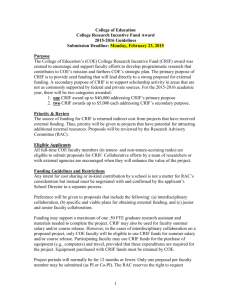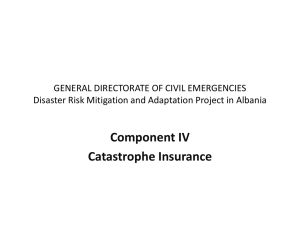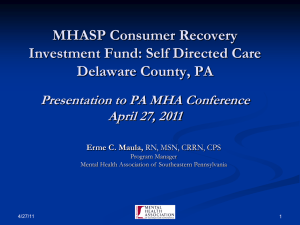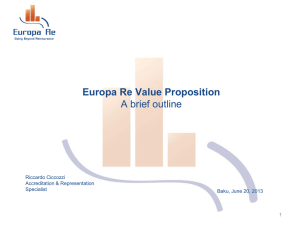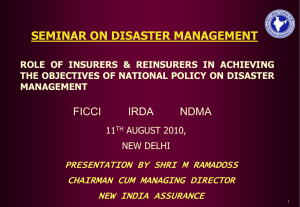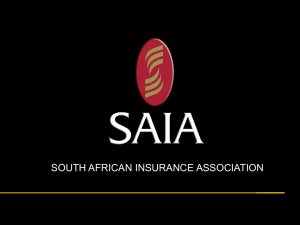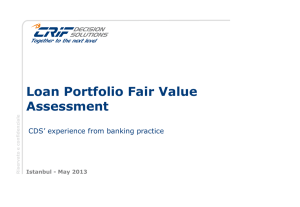DMS - Donor Coordination Forum in Bosnia and Herzegovina
advertisement
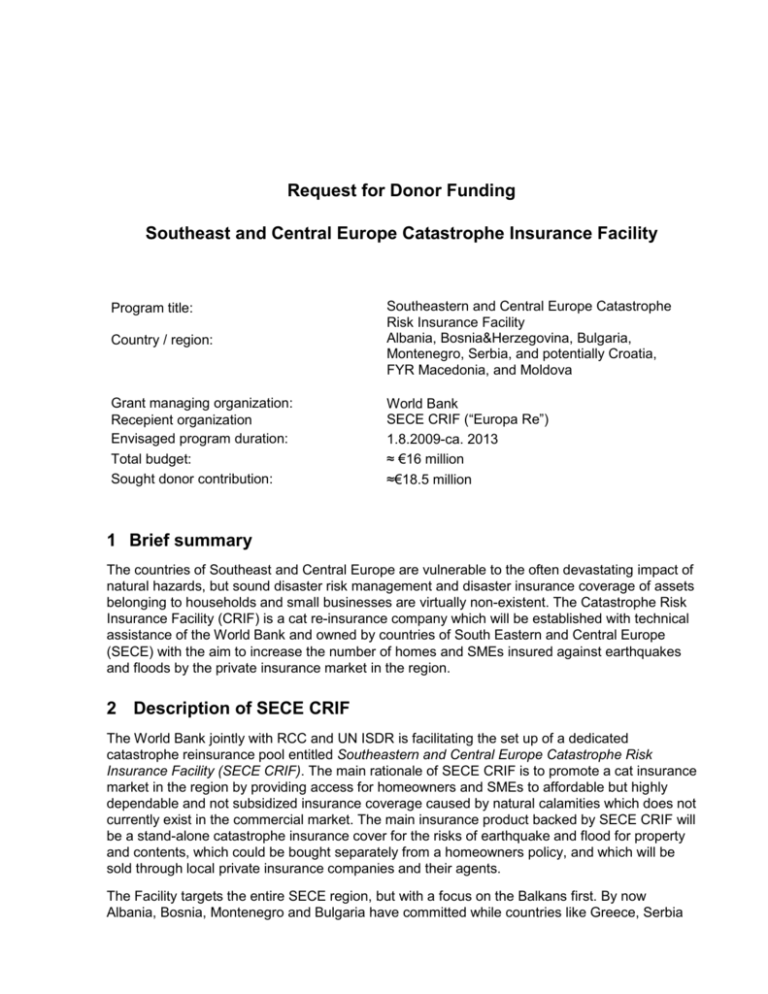
Request for Donor Funding Southeast and Central Europe Catastrophe Insurance Facility Country / region: Southeastern and Central Europe Catastrophe Risk Insurance Facility Albania, Bosnia&Herzegovina, Bulgaria, Montenegro, Serbia, and potentially Croatia, FYR Macedonia, and Moldova Grant managing organization: Recepient organization Envisaged program duration: Total budget: Sought donor contribution: World Bank SECE CRIF (“Europa Re”) 1.8.2009-ca. 2013 ≈ €16 million ≈€18.5 million Program title: 1 Brief summary The countries of Southeast and Central Europe are vulnerable to the often devastating impact of natural hazards, but sound disaster risk management and disaster insurance coverage of assets belonging to households and small businesses are virtually non-existent. The Catastrophe Risk Insurance Facility (CRIF) is a cat re-insurance company which will be established with technical assistance of the World Bank and owned by countries of South Eastern and Central Europe (SECE) with the aim to increase the number of homes and SMEs insured against earthquakes and floods by the private insurance market in the region. 2 Description of SECE CRIF The World Bank jointly with RCC and UN ISDR is facilitating the set up of a dedicated catastrophe reinsurance pool entitled Southeastern and Central Europe Catastrophe Risk Insurance Facility (SECE CRIF). The main rationale of SECE CRIF is to promote a cat insurance market in the region by providing access for homeowners and SMEs to affordable but highly dependable and not subsidized insurance coverage caused by natural calamities which does not currently exist in the commercial market. The main insurance product backed by SECE CRIF will be a stand-alone catastrophe insurance cover for the risks of earthquake and flood for property and contents, which could be bought separately from a homeowners policy, and which will be sold through local private insurance companies and their agents. The Facility targets the entire SECE region, but with a focus on the Balkans first. By now Albania, Bosnia, Montenegro and Bulgaria have committed while countries like Greece, Serbia and Croatia expressed interest in joining the SECE CRIF. A recent conference organized by the Bank revealed that the other Western Balkans countries are also strongly interested in the Program and likely to join, although at a later stage. The Regional Cooperation Council (formerly Stability Pact) is instrumental, through its secretary-general, in promoting SECE CRIF among the Balkan countries and encouraging their participation. SECE CRIF Business Model The business model of SECE-CRIF and its mechanics are depicted in the two figures below: SECE CRIF at a glance The figures above demonstrate that SECE CRIF will be set up as a genuine Public-Private Partnership whose major elements are as follows: Public Ownership: Due to the critical importance of governments in creating and supporting the demand for cat insurance among homeowners and SMEs, the Facility will in the initial stage be owned and governed by member countries. Private Management: SECE CRIF will be managed by a special purpose, limited liability company under the likely name of EUROPA RE. It will be a privately-owned insurance services firm, providing underwriting, pricing and risk management support to the local primary insurers, as well as placing reinsurance on behalf of SECE CRIF and, if necessary, entering into alternative risk financing arrangement with risk capital providers. Corporate Governance: To ensure that the management of SECE CRIF is immune from potential political pressures that may adversely affect its operational and financial performance, one of the key elements envisaged by the business plan is a clear separation of the company’s business operations from the government ownership of the Facility. EUROPA RE will thus have an independent professional board of directors consisting of reputable insurance/reinsurance professionals with a well established track record in the industry. Overall strategic oversight and policy advice will remain with the company’s shareholders (the Ministries of Finance of the member countries) and exercised through the Annual Meetings of Shareholders and the Advisory Policy Board. Exit strategy: The government shareholders will be able to sell up to 30% of their shares in 3 years from the commencement of SECE CRIF operations and up to 100% within 5 years to private investors. Registration, Regulation and Supervision: EUROPA RE will be domiciled and regulated in Switzerland which has a highly advanced and sound insurance regulatory regime. On February 4, 2009, the Swiss financial market regulator (FINMA) issued a preliminary approval to the World Bank for the registration and granting of the operating license for EUROPA RE. Subject to the submission of a final business plan, the capitalization of EUROPA RE and the recruitment of the company manager, the FINMA will issue the final operating license in the second quarter of this year. SECE CRIF will also maintain a close dialogue with the participating countries’ insurance regulators to ensure compliance of the cat insurance products with the local statutory norms and regulations. 3 Beneficiaries The key beneficiaries of SECE CRIF are homeowners and SMEs who will be able to buy a dependable stand-alone cat insurance cover separately from a fire policy at a competitive price. Farmers are also likely to be among the main beneficiaries as climate change makes floods more extreme and frequent with the brunt falling on agricultural producers. Moreover, direct beneficiaries include local insurance companies in the participating countries who will be able to expand and deepen their business. The ultimate beneficiaries are the participating states and governments who will be able to reduce the level of economic and fiscal exposure to natural disasters in the very near future. Once operational, the facility will also lessen the pressure on the EU Solidarity Fund and EU countries who are major contributors to the Fund in the case of a major catastrophic event in one of the SECE CRIF member states. 4 Program activities to be funded by donors The World Bank aims at making SECE CRIF operational by August, 2009. So far, all project preparation work has been funded jointly by the Bank, GFDRR, UN ISDR, and RCC which together have spent to the tune of USD 0.7 million on consultants and staff time. Once facility becomes operational, further technical work will be financed by a USD 2.5 million grant from SECO, which will assist the CRIF in carrying out key preparatory technical activities such as country risk assessments, and development of actuarial and underwriting tools as well as the compensation of the independent Board of Directors during the start-up phase and the fees for the registration of the Facility in Switzerland by way of an equity injection. However, despite all the efforts, the launch the program has been hampered by the global financial crisis which severely affected countries’ ability to make the expected equity contributions to the facility. So far, out of the minimum capital of €16 million required to finance country contributions only Albania was able to lock in a $2.0 million equity contribution to the facility by borrowing from the Bank for a disaster preparedness project – but even that amount is not certain as the project has not been made effective yet. Hence, the Bank, jointly with its regional partners – the Regional Cooperation Council and the UN ISDR – is currently seeking donors’ contributions toward this important regional initiative. The expected equity contributions of the countries that have already expressed their interest to join the program in FY09 are as follows: Country Equity contribution FY (USD MM) Albania 2.0 FY09 Bosnia and Herzegovina 2.7 FY09 Bulgaria 5.0 FY09 Montenegro 1.0 FY9 Serbia 5.0 FY9 Total 15.7 It is expected however that several other countries of the region such as Montenegro, Moldova, and Croatia and possibly several countries of Central Europe are likely to join the program as well over the next few years. In addition to the countries’ equity contributions, the Bank is seeking US 5 mm to finance the management contract for the first five years of the facility operations as the facility’s operational income during the start-up phase will be insufficient to cover its fixed costs. Hence, all-in-all, the overall contribution sought from donors amounts to USD 20.7 million or about €16 million at today’s exchange rate. See Table below. Activities to be financed Amount (USD mm) Country equity contributions 15.7 Management contract 5.00 Total 20.7 5 Organisation of the Program 5.1 Roles and Responsibilities Governments: The member states play a fundamental part in ensuring SECE CRIF’s success by participating in the financing of the Facility as well as its governance (through the shareholders meetings and in the policy advisory board), and by providing all necessary logistical and technical support to the various consultants entrusted with the country risk assessments so as to ensure expeditious and effective completion of these studies. Even more important, however, is their policy support which may vary from country to country and include, but is not limited to: Create the enabling regulatory and legal framework for the operations of SECE CRIF; Carry out extensive public information and awareness campaigns about the availability and benefits of catastrophe insurance products; implement policies that will encourage sound disaster risk managements practices by homeowners and companies, including linking mortgages in disaster prone areas to cat insurance and limiting post-disaster aid to a defined amount or a fraction of the insured limit; Insure with SECE CRIF all government owned housing stock against the risk of natural disasters; Management company: SECE CRIF will be managed by an independent insurance services company with dedicated and highly experienced full time staff. The company will be selected through a global tender according to established World Bank rules and procedures on the basis of: technical qualifications of the proposed management team, IT capabilities and cost. To ensure the quality of SECE CRIF’s operations, compensation of the company will be linked to the operational performance of the Facility. The company is also expected to adopt the state of the art risk management systems. In fact, besides minimum capital requirements obligated by Solvency I, as of 2011 the company will have to comply with risk-based solvency requirements prescribed by the Swiss Solvency Test. Local insurers: Locally licensed private insurance companies will issue catastrophe insurance policies to homeowners and SMEs in participating countries and will settle claims. To transfer the catastrophe insurance risk assumed in the process of selling these products, primary insurers will then enter into a reinsurance contract with SECE CRIF, which will cover a major part of the risk under these insurance policies. Reinsurance coverage will be provided automatically for all insurance policies issued by insurers in accordance with the recommended risk underwriting and pricing guidelines of the Facility. Insurers will also be relied upon to settle claims arising from catastrophic events. Training will be given to insurers’ loss adjusters by SECE CRIF to ensure consistency in claims handling across the region. Primary insurers will be compensated by receiving insurance commissions for their distribution and claims settlement fees. In addition, those insurers who will choose to retain a part of risk under the catastrophe risk policies reinsured with SECE CRIF, will also receive a part of risk premium. 6 Expected results The most important benefit of SECE CRIF at outcome level is the provision of affordable access to cat insurance. In line with the achievements of the Turkish program, the aim here is to raise cat insurance penetration among homeowners from the current 2-5% to 20-25% of insurable homes over the next 8 years without making the insurance compulsory. The impact of SECE CRIF should be felt at three levels: In the case of households, access to affordable disaster insurance will serve as an important financial safety net that will help millions of homeowners to protect their lifetime savings embedded in their house equity, and hence avoid financial ruin. For businesses, access to disaster insurance will reduce the adverse impacts of natural hazards on their earnings, and thus reduce the cost of borrowing, and result in improved business valuations. At industry level, SECE CRIF contributes to financial sector deepening in the SECE region by providing a strong boost to the national insurance industries (new clients, additional premium income) and the development of national cat insurance markets more specifically. In the case of governments, investing in the development of a market-based disaster risk protection system such as SECE CRIF will bring numerous economic and fiscal benefits: it will help reduce their contingent fiscal liabilities arising out of their unlimited exposure to natural hazards, and will help to mitigate the adverse impacts of natural hazards on fiscal stability and economic growth.
